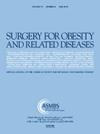A high adherence level to nutritional recommendations minimizes protein and minerals loss while maximizes visceral fat loss in bariatric surgery patients
IF 3.5
3区 医学
Q1 SURGERY
引用次数: 0
Abstract
Background
Metabolic bariatric surgeries are considered the finest and most appropriate treatment option for patients with severe obesity. Besides the surgical procedure, many factors appear to be associated with improved postoperative outcomes such as compliance to the postoperative diet and supplementation, regular physical activity, medical and nutritional follow-up, and modifications in dietary habits.
Objectives
The objectives of this study were to investigate the effect of adherence to postoperative recommendations on anthropometric measurements and body composition and assess the percentage of total weight loss (%TWL) and excess weight loss (%EWL) 3 months postoperative.
Settings
Fifty-two participants who underwent a Roux-en-Y gastric bypass or sleeve gastrectomy in the University of Jordan Hospital were included.
Methods
Participants have filled out a preoperative questionnaire. Anthropometric measurements were obtained preoperative and 3 months postoperative using a Body Impedance Analyzer (Inbody 270). The adherence to postoperative recommendations was assessed by the Bariatric Surgery Self-management Questionnaire 3 months postoperative and classified to 3 adherence levels.
Results
Most anthropometric measurements decreased 3 months postoperative in the 3 adherence groups (P ≤ .05). No significant differences were observed between groups in anthropometric measurements and body composition, except for minerals and visceral fat levels. The mineral loss has decreased in both the high and intermediate adherence groups (−.09 ± .22 kg, and −.09 ± .18 kg, respectively). Also, the high adherence group showed less loss in protein amount postoperatively (P = .06). Visceral fat level decreased in the high adherence group (P ≤ .05).
Conclusions
Adherence to postoperative behavioral and nutritional recommendations was associated with less protein and mineral loss and enhanced visceral fat reduction postoperatively.
对营养建议的高依从性可以最大限度地减少蛋白质和矿物质的损失,同时最大限度地减少减肥手术患者的内脏脂肪损失。
背景:代谢减肥手术被认为是重度肥胖患者最好和最合适的治疗选择。除手术外,许多因素似乎与术后预后的改善有关,如术后饮食和补充的依从性、定期体育活动、医疗和营养随访以及饮食习惯的改变。目的:本研究的目的是调查遵守术后建议对人体测量和身体组成的影响,并评估术后3个月总体重减轻百分比(%TWL)和多余体重减轻百分比(%EWL)。背景:52名在约旦大学医院接受Roux-en-Y胃旁路术或袖式胃切除术的参与者被纳入研究。方法:参与者填写术前问卷。术前和术后3个月使用身体阻抗分析仪(Inbody 270)进行人体测量。术后3个月通过减肥手术自我管理问卷评估患者对术后建议的依从性,并将依从性分为3个等级。结果:3个依从组术后3个月大多数人体测量值下降(P≤0.05)。除了矿物质和内脏脂肪水平外,各组之间在人体测量和身体组成方面没有显著差异。在高依从组和中等依从组中,矿物质流失都有所减少。09±0.22 kg, -。09±0.18 kg)。此外,高依从性组术后蛋白质含量损失较少(P = 0.06)。高依从组内脏脂肪水平降低(P≤0.05)。结论:坚持术后行为和营养建议与术后减少蛋白质和矿物质损失以及增强内脏脂肪减少有关。
本文章由计算机程序翻译,如有差异,请以英文原文为准。
求助全文
约1分钟内获得全文
求助全文
来源期刊
CiteScore
6.70
自引率
12.90%
发文量
570
审稿时长
56 days
期刊介绍:
Surgery for Obesity and Related Diseases (SOARD), The Official Journal of the American Society for Metabolic and Bariatric Surgery (ASMBS) and the Brazilian Society for Bariatric Surgery, is an international journal devoted to the publication of peer-reviewed manuscripts of the highest quality with objective data regarding techniques for the treatment of severe obesity. Articles document the effects of surgically induced weight loss on obesity physiological, psychiatric and social co-morbidities.

 求助内容:
求助内容: 应助结果提醒方式:
应助结果提醒方式:


